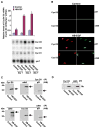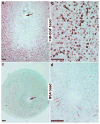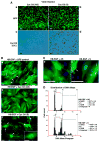HB-EGF directs stromal cell polyploidy and decidualization via cyclin D3 during implantation
- PMID: 14697362
- PMCID: PMC4277116
- DOI: 10.1016/j.ydbio.2003.09.019
HB-EGF directs stromal cell polyploidy and decidualization via cyclin D3 during implantation
Abstract
Stromal cell polyploidy is a unique phenomenon that occurs during uterine decidualization following embryo implantation, although the developmental mechanism still remains elusive. The general consensus is that the aberrant expression and altered functional activity of cell cycle regulatory molecules at two particular checkpoints G1 to S and G2 to M in the cell cycle play an important role in the development of cellular polyploidy. Despite the compelling evidence of intrinsic cell cycle alteration, it has been implicated that the development of cellular polyploidy may be controlled by specific actions of extracellular growth regulators. Here we show a novel role for heparin-binding EGF-like growth factor (HB-EGF) in the developmental process of stromal cell polyploidy in mice. HB-EGF, which is one of the earliest known molecular mediators of implantation in mice and humans, promotes stromal cell polyploidy via upregulation of cyclin D3. Adenoviral delivery of antisense cyclin D3 attenuates cyclin D3 expression and abrogates HB-EGF-induced stromal cell polyploidy in vitro and in vivo. Collectively, the results demonstrate that the regulation of stromal cell polyploidy and decidualization induced by HB-EGF depend on cyclin D3 induction.
Figures







Similar articles
-
Evidence for coordinated interaction of cyclin D3 with p21 and cdk6 in directing the development of uterine stromal cell decidualization and polyploidy during implantation.Mech Dev. 2002 Feb;111(1-2):99-113. doi: 10.1016/s0925-4773(01)00614-1. Mech Dev. 2002. PMID: 11804782 Free PMC article.
-
Cellular and molecular responses of the uterus to embryo implantation can be elicited by locally applied growth factors.Proc Natl Acad Sci U S A. 2001 Jan 30;98(3):1047-52. doi: 10.1073/pnas.98.3.1047. Proc Natl Acad Sci U S A. 2001. PMID: 11158592 Free PMC article.
-
Cyclin D3 in the mouse uterus is associated with the decidualization process during early pregnancy.J Mol Endocrinol. 1999 Feb;22(1):91-101. doi: 10.1677/jme.0.0220091. J Mol Endocrinol. 1999. PMID: 9924184
-
Cell cycle regulatory control for uterine stromal cell decidualization in implantation.Reproduction. 2009 Jun;137(6):889-99. doi: 10.1530/REP-08-0539. Epub 2009 Mar 23. Reproduction. 2009. PMID: 19307426 Review.
-
HB-EGF: a unique mediator of embryo-uterine interactions during implantation.Exp Cell Res. 2009 Feb 15;315(4):619-26. doi: 10.1016/j.yexcr.2008.07.025. Epub 2008 Aug 3. Exp Cell Res. 2009. PMID: 18708050 Free PMC article. Review.
Cited by
-
Overexpression of cyclin D3 improves decidualization defects in Hoxa-10(-/-) mice.Endocrinology. 2012 Nov;153(11):5575-86. doi: 10.1210/en.2012-1528. Epub 2012 Sep 24. Endocrinology. 2012. PMID: 23008516 Free PMC article.
-
The Multiple Functions of HB-EGF in Female Reproduction and Related Cancer: Molecular Mechanisms and Targeting Strategies.Reprod Sci. 2024 Sep;31(9):2588-2603. doi: 10.1007/s43032-024-01454-6. Epub 2024 Feb 29. Reprod Sci. 2024. PMID: 38424408 Review.
-
Death effector domain-containing protein (DEDD) is required for uterine decidualization during early pregnancy in mice.J Clin Invest. 2011 Jan;121(1):318-27. doi: 10.1172/JCI44723. Epub 2010 Dec 6. J Clin Invest. 2011. PMID: 21135503 Free PMC article.
-
Rhythm of the First Language: Dynamics of Extracellular Vesicle-Based Embryo-Maternal Communication in the Pre-Implantation Microenvironment.Int J Mol Sci. 2023 Apr 6;24(7):6811. doi: 10.3390/ijms24076811. Int J Mol Sci. 2023. PMID: 37047784 Free PMC article.
-
Involvement of atypical transcription factor E2F8 in the polyploidization during mouse and human decidualization.Cell Cycle. 2015;14(12):1842-58. doi: 10.1080/15384101.2015.1033593. Cell Cycle. 2015. PMID: 25892397 Free PMC article.
References
-
- Alexander CM, Hansell EJ, Behrendtsen O, Flannery ML, Kishnani SP, Hawkes SP, Werb Z. Expression and function of matrix metalloproteinases and their inhibitors at the maternal-embryonic boundary during mouse embryo implantation. Development. 1996;122:1723–1736. - PubMed
-
- Bahar R, O-Wang J, Kawamura K, Seimiya M, Wang Y, Hatano M, Okada S, Tokuhisa T, Watanabe T, Tagawa M. Growth retardation, polyploidy, and multinucleation induced by Clast3, a novel cell cycle-regulated protein. J Biol Chem. 2002;277:40012–40019. - PubMed
-
- Ballester A, Frampton J, Vilaboa N, Cales C. Heterologous expression of the transcriptional regulator escargot inhibits megakaryocytic endomitosis. J Biol Chem. 2001;276:43413–43418. - PubMed
-
- Carson DD, Bagchi I, Dey SK, Enders AC, Fazleabas AT, Lessey BA, Yoshinaga K. Embryo implantation. Dev Biol. 2000;223:217–237. - PubMed
Publication types
MeSH terms
Substances
Grants and funding
LinkOut - more resources
Full Text Sources

